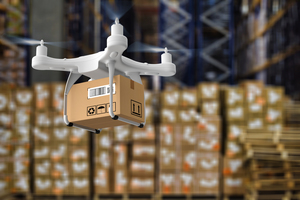

|
Edward Lowton
Editor |


|
| Home> | Plant, Process & Control | >Robotics & Automation | >The benefits and potential of robotics in warehousing |
The benefits and potential of robotics in warehousing
22 March 2023
Robotics can enable logistics operators to create robust, responsive and reliable warehouse environments despite economic headwinds, says Simon Jones

ROBOT DEPLOYMENT can significantly enhance the warehouse and logistics environment. A recent Gartner report, Emerging technologies: smart robot adoption generates diverse business value, highlighted that robots used to replenish retail stores demonstrate quantifiable results in 72% of use cases - the highest percentage among industries. The analyst firm forecast in the report that by 2030, 80% of humans will engage with robots daily, and for many, this may be in the workplace.
Addressing labour shortages
One of the key challenges facing retailers and logistics operators is labour shortages, which are seriously impacting operations across the UK. Many are also experiencing difficulties with staff retention. Working in a warehouse environment is physically exhausting and often mundane and brings with it a number of health and safety risks due to the nature of the work. These issues severely impact throughput and make it much harder to keep up with demand.
This is where robots can provide value. ‘Tedious’ jobs typically carried out by humans can instead be done by autonomous mobile robots (AMRs), eliminating non-productive walking time, which makes up 60% of manual picking time.
With an automated system in place, human staff can take on more technical, skilled tasks within the warehouse environment, adding value to their roles and reducing the most strenuous elements. For example, there is a need for human workers to monitor the performance of machines and carry out elements of the order picking and packing processes that cannot be automated. Additionally, AMRs can help to reduce workplace incidents and support the health, safety and wellbeing of warehouse workers.
Maximising warehouse space
The short supply and high cost of land is also impacting retailers wishing to expand their facilities to keep up with consumer demand, keep shelves stocked and eCommerce orders fulfilled. Building an entire new warehouse can be prohibitively expensive, so integrating robots that make the very most of existing space is paramount.
Robotic picking systems, for example, can retrieve products quickly and efficiently even if they are stored on racks several metres above the ground, which would be inefficient or unsafe for human staff to do. This means companies can maximise the height and depth of their warehouses, leading to greatly increased storage combined with enhanced efficiency. Effectively, the people power gap is plugged, and existing facilities are fit for purpose once more.
Peak time power-up
Picking robots can also speed up processes during busy periods, such as Christmas and Black Friday. This is due not just to the fact that they can retrieve products and bring them to picking stations faster than human staff, but also because extra robots can simply be added when demand picks up and removed once things quieten down again. This reduces the need to recruit swathes of seasonal workers, who would typically need a month of training before they are up to speed.
This is especially important for organisations experiencing a high level of growth or fluctuations in demand in the eCommerce space. Robots and their complementary systems enable retailers to scale when they need to, adding or removing robots, racks and bins in line with demand. Operations can be scaled quickly and easily to meet future demand, so that nothing more than what is needed is installed. This sets these systems apart from more rigid traditional automation solutions.
Simon Jones is senior sales executive UK at Exotec
For more information:
Tel: +33 972585634
- No related articles listed
- Latest robots: Slim and easy to install
- APP that controls robots
- Collaborative robots: Risks and rewards
- Precision bearings aid smart grasping
- Collaborative robots: Safety matters
- 3D simulation program for robot control
- Bearings chosen for robotic exoskeletons
- Cobot collaboration delivers entry-level vision-guidance
- Robots boost profitability for machining company
- Entry-level vision-guided cobot system


















